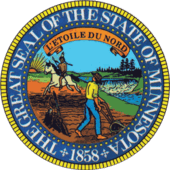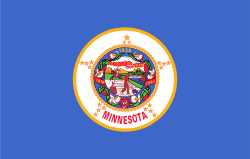Adolph Olson Eberhart
| Adolph Olson Eberhart | |
|---|---|
|
Adolph Olson Eberhart | |
| 17th Governor of Minnesota | |
|
In office September 21, 1909 – January 5, 1915 | |
| Lieutenant |
Edward Everett Smith Samuel Y. Gordon Joseph A. A. Burnquist |
| Preceded by | John Albert Johnson |
| Succeeded by | Winfield Scott Hammond |
| 17th Lieutenant Governor of Minnesota | |
|
In office January 7, 1907 – September 21, 1909 | |
| Governor | John Albert Johnson |
| Preceded by | Ray W. Jones |
| Succeeded by | Edward Everett Smith |
| Personal details | |
| Born |
June 23, 1870 Värmland, Sweden |
| Died |
December 6, 1944 (aged 74) Savage, Minnesota, United States |
| Political party | Republican |
| Spouse(s) | Adele O.M. Koke |
| Profession | politician |
| Religion | Lutheran |
Adolph Olson Eberhart (June 23, 1870 – December 6, 1944) was an American politician, who served as the 17th Governor of Minnesota.
Background
Adolph Olson Eberhart was born in Kil, in Värmland, Sweden, the son of Andrew and Louise Olson. Because of bad economic conditions, Andrew, Louise and all of the family except Adolph emigrated to St. Peter, Minnesota. In 1882, Adolph joined the family there. Eberhart graduated from Gustavus Adolphus College, St. Peter, Minnesota (1895) and studied law in a law office in Mankato, Minnesota.[1]
Career

Eberhart was a member of the Minnesota State Senate from January 1903 to January 1907. He was elected the 17th Lieutenant Governor in 1906. He became the 17th Governor of Minnesota on September 21, 1909, when Governor John Albert Johnson died, and served until January 5, 1915. Eberhart was a Republican. Minnesota elected Governors and Lt. Governors on separate ballots until 1974, so it happened occasionally that the two were of different parties. Elected the youngest member of the state senate in 1902, the Republican Eberhart was chosen as lieutenant governor four years later in the administration of the legendary Democrat, John Albert Johnson. Although his first partial term as governor resulted from Johnson's death in 1909, he subsequently won the office twice on his own merits.[2][3]
An efficient administrator, Eberhart was also a consummate politician, and his detractors, including many Republicans, questioned his sincerity as well as the reputation of certain close associates. To assure his re-nomination in 1912, he called a special 13-day legislative session and deflated his critics by bulldozing through such progressive reforms as rural school consolidation and primary elections. Eberhart's strategy worked; he avoided the censure of his own party and was re-nominated for a second full term in the first statewide primary.[4]
Eberhart lost his re-nomination bid for a fourth term as governor. A second defeat in the 1916 U.S. Senate primary marked the end of his political career. After a career as a real estate and insurance executive in Chicago, he retired to a rest home where he died in Savage, Minnesota. An inventory of his gubernatorial records are maintained at the Minnesota Historical Society Library.[5]
References
- ↑ Eberhart, Adolph Olson (Minnesota Historical Society)
- ↑ A. O. (Adolph Olson) Eberhart (Minnesota Historical Society)
- ↑ Minnesota Governor Adolph Olson Eberhart (National Governors Association)
- ↑ Eberhart, Adolph Olson "A.O." (Minnesota Legislators Past and Present)
- ↑ Minnesota Governor: Eberhart. Records (Minnesota Historical Society. State Archives)
External links
| Wikimedia Commons has media related to Adolph Olson Eberhart. |
| Political offices | ||
|---|---|---|
| Preceded by Ray W. Jones |
Lieutenant Governor of Minnesota 1907 – 1909 |
Succeeded by Edward Everett Smith |
| Preceded by John Albert Johnson |
Governor of Minnesota 1909 – 1915 |
Succeeded by Winfield Scott Hammond |
| ||||||||
|


